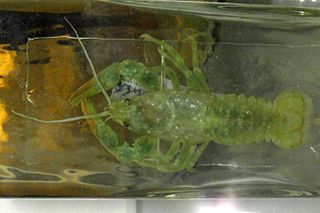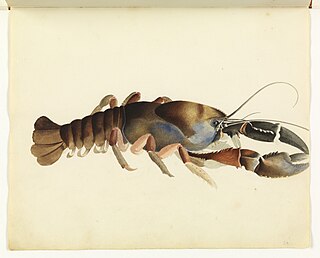
Crayfish are freshwater crustaceans belonging to the clade Astacidea, which also contains lobsters. Taxonomically, they are members of the superfamilies Astacoidea and Parastacoidea. They breathe through feather-like gills. Some species are found in brooks and streams, where fresh water is running, while others thrive in swamps, ditches, and paddy fields. Most crayfish cannot tolerate polluted water, although some species, such as Procambarus clarkii, are hardier. Crayfish feed on animals and plants, either living or decomposing, and detritus.

Astacus is a genus of crayfish found in Europe, comprising three extant (living) species and three extinct fossil species.

Cambarus is a large and diverse genus of crayfish from the United States and Canada. The adults range in size from about 5 cm (2.0 in) up to approximately 15 cm (5.9 in).

King crabs are a taxon of decapod crustaceans that are chiefly found in cold seas. Because of their large size and the taste of their meat, many species are widely caught and sold as food with the most common being the red king crab.

Pontastacus is a genus of freshwater crayfish occurring in eastern Europe and western Asia.

The Parastacidae are the family of freshwater crayfish found in the Southern Hemisphere. The family is a classic Gondwana-distributed taxon, with extant members in South America, Madagascar, Australia, New Zealand, and New Guinea, and extinct taxa also in Antarctica.

Astacidae is a family of freshwater crayfish native to Europe and western North America. The family is made up of four extant (living) genera: The genera Astacus, Pontastacus, and Austropotamobius are all found throughout Europe and parts of western Asia, while Pacifastacus is found on the Pacific coast of the United States and British Columbia and includes the signal crayfish and the Shasta crayfish.

The Cambaridae are the largest of the four families of freshwater crayfish, with over 400 species. Most of the species in the family are native the United States east of the Great Divide and Mexico, but fewer range north to Canada, and south to Guatemala and Honduras. Three live on the island of Cuba. The species in the genus Cambaroides are the only found outside North America, as they are restricted to eastern Asia.

Pardaliscidae is a family of amphipods, whose members typically inhabit the deepest parts of ocean basins. It contains the following genera:

Orconectes is a genus of cave dwelling freshwater crayfish, endemic to suitable habitats in the eastern United States. Surface dwelling species, formerly categorised here, were moved to Faxonius in 2017.

Procambarus is a genus of crayfish in the family Cambaridae, all native to North and Central America. It includes a number of troglobitic species, and the marbled crayfish (marmorkrebs), which is parthenogenetic. Originally described as a subgenus for four species, it now contains around 161 species.

Diplurus is a genus of prehistoric mawsoniid coelacanth fish which lived during the Late Triassic-Early Jurassic period in North America. The fossils of this genus are common on the eastern North American Margin, being a key taxon of the Newark Supergroup, and recovered from units such as the Bull Run Formation, Lockatong Formation, Stockton Formation, Solite Quarry, Midland Formation, East Berlin Formation, Boonton Formation and the Portland Formation. Three species are know, the type D. longicaudatus, the youngest and biggest, D. newarki, the oldest, followed then by "D. uddeni" (Eastman), also from older rocks and considered dubious. A recent work has recovered a 3rd or 4th species, D. enigmaticus, from the Late Triassic of New Jersey, representing another small-bodied form living in sympatry with the similarly-sized D. newarki. This genus ranges in size from 15 cm of D. newarki and D. enigmaticus in New Jersey to the larger 60 cm specimens of Diplurus longicaudatus found in the Connecticut River Valley, which indicates a considerable growth and likely a changue in the ecological position of the genus to a possible apex predatory niche.

Paralomis is a genus of king crabs. It includes the following 69 species:

Cambaroides dauricus is a species of crayfish endemic to north-eastern China, the Korean Peninsula and neighbouring parts of Russia.
Cambaroides sachalinensis is a species of freshwater crayfish endemic to Sakhalin, Russia.

Cambaroides schrenckii is a species of crayfish endemic to north-eastern China and Russia. It is a freshwater species that also occurs in some brackish water areas. It occurs in habitats with still water, typically no more than 1 metre deep. It was named after Leopold von Schrenck.
Cambaroides wladiwostokensis is a species of crayfish endemic to Primorsky Krai (Vladivostok) in Far East Russia.

Astacopsis is a genus of crayfish endemic to the island of Tasmania. There are three extant species, Astacopsis gouldi, Astacopsis franklinii, and Astacopsis tricornis. All are threatened by illegal harvesting, and A. gouldi is protected by law. A. franklinii is found in the eastern half of the island, with A. tricornis taking its place in the west. A. gouldi is found only in rivers draining into the Bass Strait, except for the Tamar River.

Cherax snowden is a species of crayfish from West Papua in Indonesia. In the wild, they live in freshwater river tributaries. It is popular as a freshwater aquarium pet across Asia, Europe, and North America because of its orange-tipped claws. Specimens were previously misidentified as members of Cherax holthuisi, also from West Papua.
Astyra is a genus of amphipods in the family Stilipedidae. It contains 6 species.

















